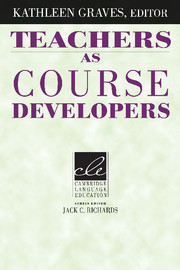Book contents
- Frontmatter
- Contents
- Contributors
- Series editor's preface
- Preface
- Acknowledgments
- 1 Teachers as course developers
- 2 A framework of course development processes
- 3 Designing workplace ESOL courses for Chinese health-care workers at a Boston nursing home
- 4 Designing a seventh-grade social studies course for ESL students at an international school
- 5 Designing an EAP course for postgraduate students in Ecuador
- 6 Designing a writing component for teen courses at a Brazilian language institute
- 7 Planning an advanced listening comprehension elective for Japanese college students
- 8 A curriculum framework for corporate language programs
- Further reading
- Index
1 - Teachers as course developers
Published online by Cambridge University Press: 18 December 2009
- Frontmatter
- Contents
- Contributors
- Series editor's preface
- Preface
- Acknowledgments
- 1 Teachers as course developers
- 2 A framework of course development processes
- 3 Designing workplace ESOL courses for Chinese health-care workers at a Boston nursing home
- 4 Designing a seventh-grade social studies course for ESL students at an international school
- 5 Designing an EAP course for postgraduate students in Ecuador
- 6 Designing a writing component for teen courses at a Brazilian language institute
- 7 Planning an advanced listening comprehension elective for Japanese college students
- 8 A curriculum framework for corporate language programs
- Further reading
- Index
Summary
Purpose of this book
One afternoon, a teacher came into my office to discuss an independent study. “I have been asked to design an evening English course for adults in my town in Nicaragua.” He paused and then continued, “I've never developed a course before. Are there any guidelines? Is there a procedure to follow? Where do I start?” I realized as I listened to him that I had heard these questions many times before, from many teachers, the difference being the nature of each teacher's situation. For example, one teacher explained that her school needed a course for the preteens who had finished their children's course but were too young for the teen course. Another teacher said, “I'm given some books and then told I can teach any way I want.” A fourth teacher explained, “My students are in danger of losing their first language literacy. How do I design a course that enables them to maintain literacy in both languages?” The situations were different, but the questions were the same: Are there any guidelines? What do I do? Where do I start?
These teachers' situations are not unusual, as teachers are increasingly being called upon to design the courses they teach (Breen 1987; Nunan 1987; Richards 1990; Yalden 1987).
- Type
- Chapter
- Information
- Teachers as Course Developers , pp. 1 - 11Publisher: Cambridge University PressPrint publication year: 1996
- 2
- Cited by



